Review: LG Stylo 4 for Cricket Wireless
Aug 6, 2018, 8:15 AM by Eric M. Zeman
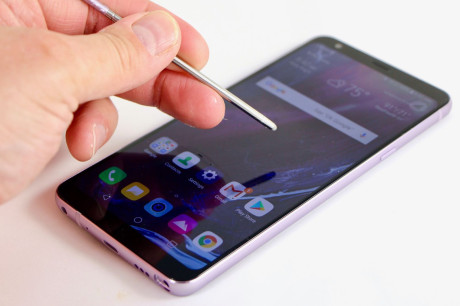
The Stylo 4 is the most affordable Android phone to include a stylus. Using the pen and huge screen together, you can do all sorts of creative and fun things. Here is Phone Scoop's in-depth review.
Hardware
Is It Your Type?
The LG Stylo 4 is an enormous Android phone that's augmented by a stylus. If you want one of the biggest screens in the market and enjoy the added creativity boost thanks to the stylus, the Stylo 4 is one of the only affordable options on the market.
Body
The LG Stylo 4 is a budget Galaxy Note. It's about one-third the cost of Samsung's flagship and relies on the included stylus to set it apart from other big-screened phones. It's made from a mix of glass, metal, and plastic. It's the most stylish Stylo yet.
A smooth metal frame wraps around the outer sides of the phone. I like the gentle curve and the reflective chamfer on the front-facing edge. It's a pleasing frame that gives the Stylo 4 plenty of strength. The front glass is fitted flush with the frame.
LG opted for a plastic rear panel. It has a glossy finish over a faux metallic pattern. I managed to scratch the rear panel pretty quickly. Consider yourself warned. From a distance, the Stylo 4 looks flashy.
This phone is about the same size as the Galaxy S9+. It's tall and wide, making it a two-handed device for sure. Some may find its 6.3-inch height and 3.06-inch width too much. I'd just call it hefty. The profile makes the phone obvious in your pocket. I didn't have any trouble cramming it into my jeans or shorts, but some might. The smooth surfaces make it easy to drop in.
Previous generations of the Stylo series were more obviously plastic, which cheapened the appearance some. The design of the Stylo 4 is far classier. The metal frame is solid and the glass front and plastic rear panels are pressed in snugly. I didn't spot any uneven seams. The Stylo 4 is well-made.
The front reminds me just a bit of the LG-made Pixel 2 XL. The corners are rounded somewhat squarely. The display fills most of the front, but there's still a bit of a chin and forehead. The slit cut into the glass for the earpiece is hardly visible at all, as is the user-facing camera. There are no physical buttons or controls, nor any logos painted onto the glass; it's a clean black surface.
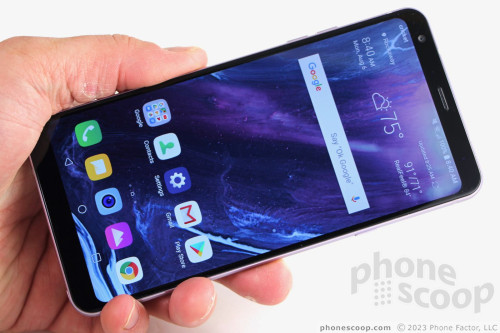
The screen lock button is placed high on the right edge. It's a tad small, though the profile is good. Travel and feedback are excellent. The volume buttons — two separate keys — are opposite, on the left side. The offer the same size, profile, and feedback as the screen lock button (very good.) The tray for SIM and memory cards is also on the left edge. It holds the cards side by side, so the tray is rather large. The USB-C port, headphone jack, and speakerphone holes are on the bottom edge.
The Stylo 4's stylus is tucked into the bottom right corner of the phone. There's no fancy spring action to pop it out; instead, there's a notch for your fingernail so you can pry the stylus from its home. It snaps in firmly. The phone vibrates when you remove the stylus or return it to the slot. The stylus itself is fairly short. It's a simple metal stylus and doesn't include an action button like the one of the Galaxy Note 8.
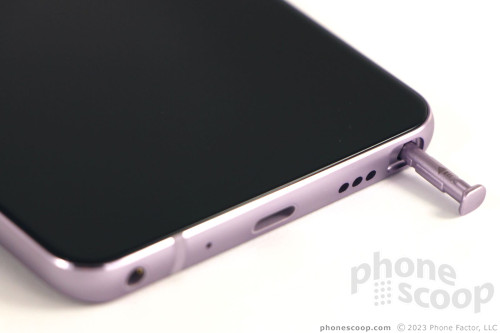
The rear panel cannot be removed. I like the curve of the plastic and the faux metal look. I think it would be better off without the glossy finish, but the finish gives it plenty of shine. It doesn't collect too many fingerprints. The camera, flash, and fingerprint reader are aligned vertically near the top. The fingerprint reader doesn't have much of an indentation and can take a second or two to find. I wish it were more distinct.
The phone is not waterproof, nor is it rugged.
LG designed a fine phone in the Stylo 4. It's a big step up from previous generations in looks, materials, and build quality. It could easily pass for a much more expensive phone.

Screen
The Stylo 4 has a 6.2-inch, full HD+ (2,160 by 1,080) display with a 2:1 aspect ratio. LG calls this FullVision. LG typically uses LCD panels and that's the case here. There's no question that it's sharp. The resolution and size combine for a pixel density of 390ppi, which is very good. Everything on the screen looks crisp and clean. It's very bright. I was able to use the phone outdoors with no problem. The screen does lose brightness when tilted; viewing angles aren't the best.
The color may be a smidge off. Whites tend to skew to blue just a little bit, giving the screen a cool look. Unfortunately, this cannot be adjusted, but there is a basic nighttime mode (blue light filter).
Signal
The Stylo 4 for Cricket runs on AT&T's LTE 4G network, (since Cricket is owned and operated by AT&T.) I tested it around the New York City metro area and found it performed on par with other Cricket-branded phones.
The Stylo 4 held onto AT&T's LTE network everywhere I took it, and was able to consistently hit the maximum speed allowed by Cricket (8Mbps). I didn't run into any trouble streaming standard definition music over the network, but watching YouTube videos (even standard resolution) via LTE led to some buffering. Browsing the web and social media apps was mostly smooth.
The phone connected all calls on the first dial but dropped one when in a moving car.
Sound
I'd call the Stylo 4 a solid phone for holding conversations. The earpiece produces calls that are loud and clear. You can easily hear callers at home, in the car, at the mall, and on city streets. Clarity was very good and voices had a nice tone to them. People said I sounded "just okay" when I spoke to them via the Stylo 4.
The speakerphone delivers a rougher experience. It's very loud, so you'll have no trouble hearing calls wherever you go. But clarity isn't great and the speaker will distort badly when turned all the way up.
Ringers and alert tones are spectacularly loud.
Battery
LG gave the Stylo 4 a 3,300mAh battery. It's a good-sized power cell and does a decent job at pushing the phone from breakfast to bedtime. The phone generally made it through a day, but only just. It typically had between 10% and 15% left by the time I plugged it back in at night. You can extend battery life a bit using the included power saver mode.
The phone does not include wireless charging, and the included charger does not charge the phone rapidly.
Bluetooth, GPS, NFC, WiFi
Bluetooth functions well. The phone paired with a range of Bluetooth accessories, including headsets, speakers, and my car. The device delivered average quality calls through headsets and my car's hands-free system. Music sounded decent via Bluetooth speakers.
Using Google Maps, the Stylo 4 was able to field my location in a few blinks of an eye. Accuracy was never better than about 25 feet. Still, Google Maps worked well enough as a real-time navigation tool.
The WiFi radio worked very well. The Stylo 4 does not have NFC.
There's an FM radio so you can listen to your favorite local stations as long as you plug in some headphones.
Software
Lock Screen
The Stylo 4 includes some of our favorite LG lock screen tools.
The phone includes KnockOn for waking the screen, but not KnockCode for unlocking it. With KnockOn, a double-tap on the screen reveals the lock screen, which includes the clock/notification combo at the top and customizable app shortcuts at the bottom. KnockOn is most helpful when the phone is sitting on a table or desk.
The lock screen clock is big and easy to see. I like that you can opt to put it in the middle or to the left. Up to five shortcuts at the bottom can include voice search, phone, messaging, photo gallery, and the camera.
Biometric security options include the fingerprint reader and facial recognition. Both are a breeze to set up. LG will warn you that the face unlock tool isn't as secure as a fingerprint, as the phone can be fooled by a photo.
I particularly appreciate that LG allows Stylo 4 owners to add extra protection to photos and QuickMemo files with a fingerprint lock.
Home Screens
The Stylo 4 ships with Android 8 Oreo and a pretty heavy user interface from LG.
Out of the box, the default home screen set up doesn't include an app drawer. This means all the apps are bundled together in folders on the home screens. There is an option for a traditional Android app drawer, however. You can also opt for the super-simple "EasyHome", for an experience more attuned to the needs of beginners.
The Stylo 4 supports all the typical customization options and settings you expect to find on a modern Android phone. You can switch up wallpapers; choose from various icon densities (4x4, 4x5, 5x5); hide apps you know you won't use often; control behaviors such as button arrangement, animations, and so on.
The main settings menu is broken down into several tabs by default, but you can adjust it so the settings all appear in one long list. It's rather dense and not that easy to use. There is a search function to help you find specific settings.
LG dropped its Smart Bulletin and lets you opt to display your own Google Feed in the left-most home screen if you wish.
The Stylo 4 ships with Qualcomm's Snapdragon 450 mid-range processor with a reasonable 3 GB of RAM. The phone always felt quick. I didn't run into any glitches or performance problems. The Stylo 4 handled split-screen multitasking and other tasks without losing steam.
Stylus
The stylus works just like your finger and interacts with everything on the phone as if it were the tip of your index finger. The only benefit to using the stylus over your finger is the stylus can be more precise. I particularly like using the stylus for entering text on the keyboard.
Pulling out the stylus automatically turns on the screen. You can select which of the pen-based features opens by default. Once the pen is removed, the stylus menu shows up in the upper right corner with several shortcuts. The first four options are preset by LG; you can choose the fifth.
Each of the stylus-oriented apps does something similar. The first, Pop Memo, is a simple app for scribbling memos. You can adjust the pen color, but that's about it. I like that this one works even when the phone is locked. This is great for those moments when you need to write something down quickly before forgetting it such as shopping list items, or reminders.
The second option, Capture+, takes a screenshot and immediately loads it into the QuickMemo editing tool.
"Pop Lens" lets you basically hold a digital magnifier over a web page or a picture so you can read it. It also lets you adjust the contrast for easier reading. (It doesn't really take advantage of the stylus, so I'm not sure why it's grouped with the stylus apps.)
The last stylus app is fun: an easy GIF creator. It drops a box on top of the screen and lets you record whatever is in the box. For example, you can place it over a video to capture a snippet of the video and turn it into a looping GIF. Neat.
Camera
The Stylo 4 doesn't have a physical camera button, but you can launch the camera from the lock screen or with a quick double press of the volume-down button. It opens swiftly.
The main viewfinder is fairly typical. It's easy to access the flash (on, off, auto), switch to the front camera, open filters, select shooting mode, or jump into the settings. HDR is hidden in the settings menu, but you can set it to "auto" so it's always on when needed.
I like that you can drag the shutter button up and down to zoom in and out. Thanks to the dedicated video capture button, it's easy to start taking video and then snap photos while shooting video.
There are eight basic shooting modes. Auto is the default mode and gives you just the tools described above. The Food mode optimizes the camera for food, such as adjusting the white balance. The Match Shot mode lets you capture two square images and paste them together into a single shot. It's dead simple to operate. Snap Shot and Grid Shot also make use of the 2:1 screen and square-shaped images. The first lets you see a preview of the image you just took right away while the second lets you create a single image from four others. Other modes are panorama, code scanner, and timelapse GIF maker. There's no manual mode or portrait mode.
The selfie camera includes its own filters and square-shaped imaging options.
Most importantly, the app runs smoothly. It never felt slow or bogged down.
Photos/Video
The main camera has a 13-megapixel camera at f/2.4. It does a decent job. The pictures I shot were sometimes blurry, but properly exposed and showed good white balance. There was some grain in the low-light pictures I took, and sometimes images lost detail in the shadows. Pictures taken outdoors with plenty of light turned out the best. It doesn't compete with flagship phones, but as a casual-use camera, it performs well enough.
The selfie camera has a 5-megapixel sensor. A screen-based flash helps when snagging selfies at night. It does all right. The fixed-focus lens produces soft results that can be grainy.
The Stylo 4 can capture full-HD video at 30fps. There are no fancy slow-motion modes. I was pleased with the video results, which were more properly exposed than regular pictures. There tended to be a heavy dose of grain in low-light scenes.
Wrap-Up
The Stylo 4 is a definite improvement over LG's previous Stylo phones. It takes a big step forward thanks to the overhauled metal design and adoption of USB-C. The big screen offers an expansive canvas on which to use the stylus. It's an appealing piece of hardware.
LG selected a decent display for the Stylo 2 that's sharp and bright. The phone did as well as any Cricket-branded phone when it came time to surf the web and make calls. Battery life was very good, though shy of excellent. Call quality was good.
LG's refinements to Android 8.1 Oreo are a bit over-the-top, but do encompass some good features. I like the flexibility of the different home screen options. The camera app is solid and puts the aspect ratio of the Stylo 4's screen to interesting use with its square-image tricks. I wish it took slightly better pictures.
The stylus is a neat extra, but by no means vital. The few apps that take advantage of the stylus offer little more than writing notes, scribbling, and marking up pictures. If you're a fan of the stylus, however, the Stylo 4 is one of the only options in the market in this price range.
The Stylo 4 costs $229 as sold by Cricket (other carrier variants may cost more). I think this is a fair price and you're getting a good value for your money.

Comments
T-Mobile Stylo 4 has NFC and Band 71


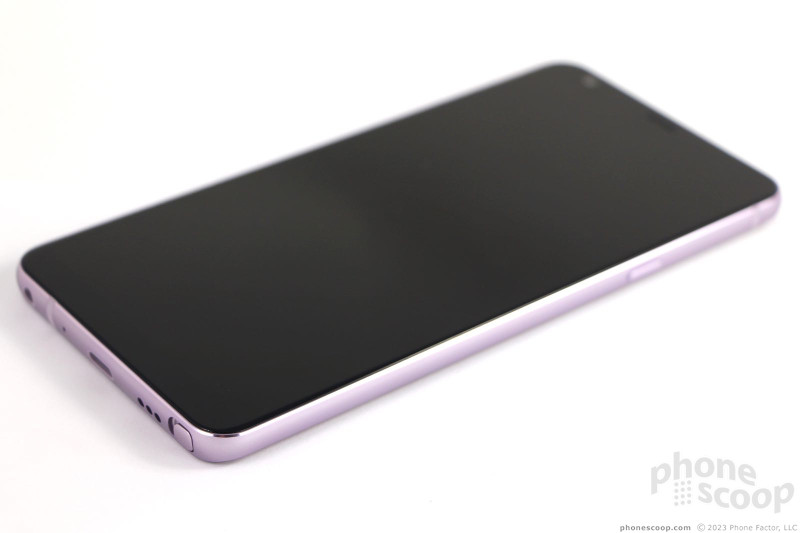










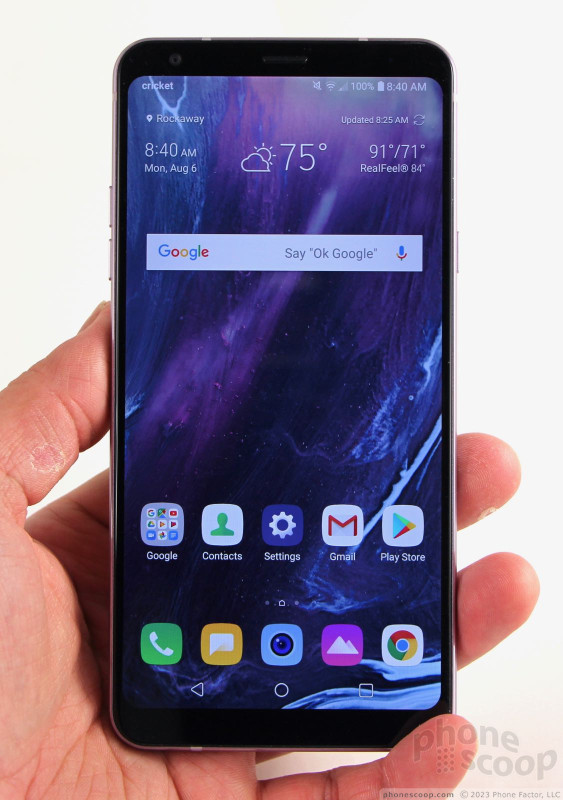










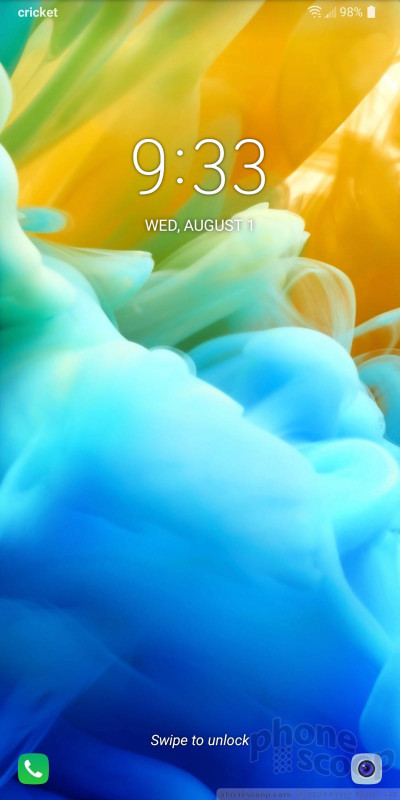





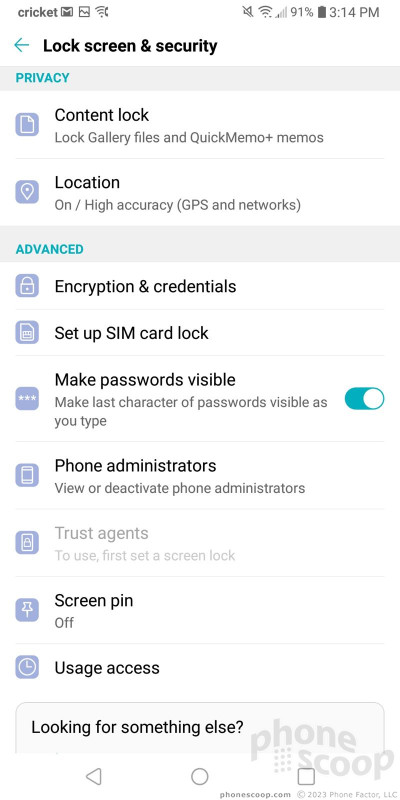





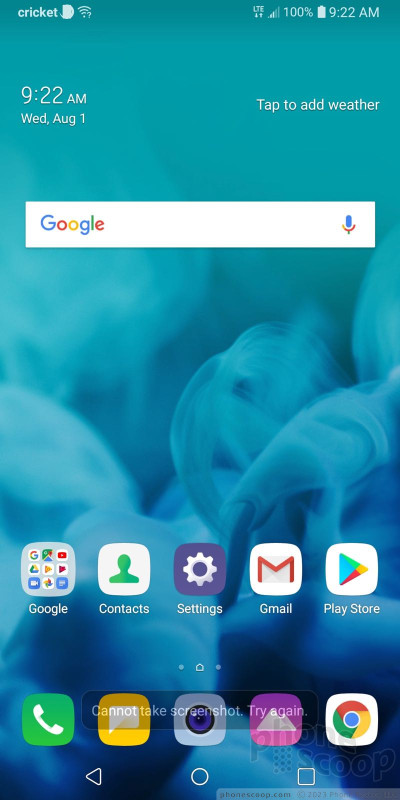









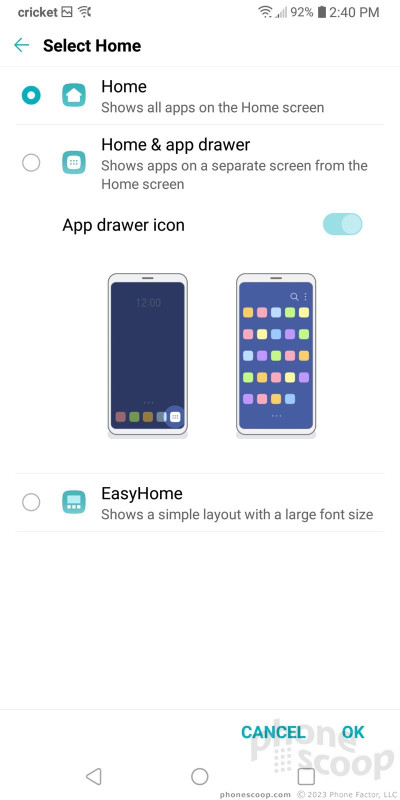









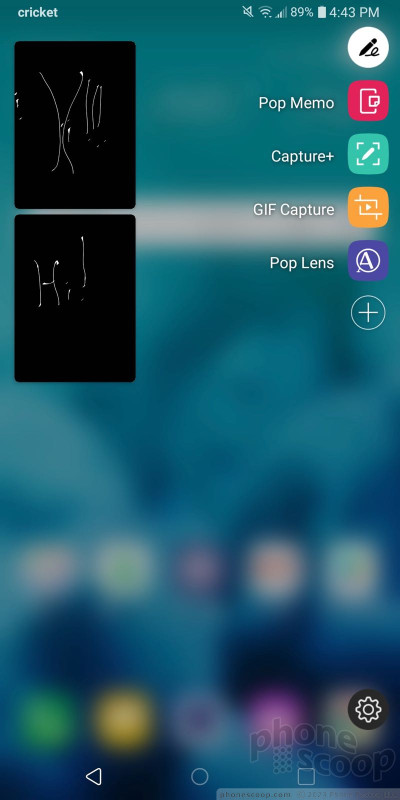











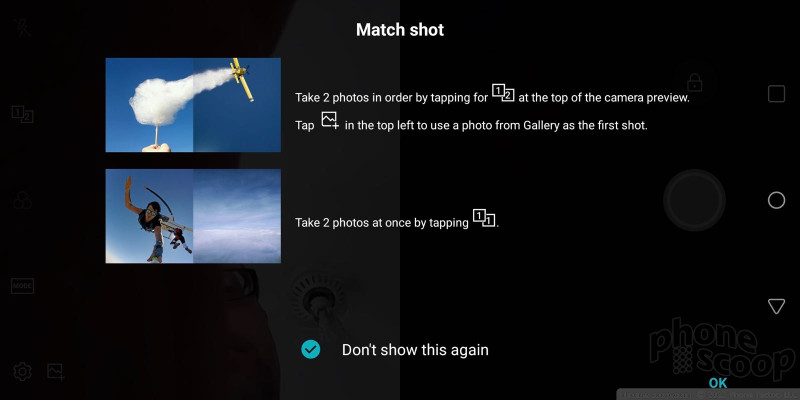






















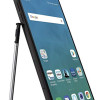 Amazon Adds LG Stylo 4 to List of Prime Exclusive Phones
Amazon Adds LG Stylo 4 to List of Prime Exclusive Phones
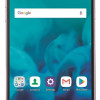 Cricket Wireless Picks Up the LG Stylo 4
Cricket Wireless Picks Up the LG Stylo 4
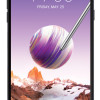 MetroPCS Adds LG Stylo 4 to Lineup
MetroPCS Adds LG Stylo 4 to Lineup
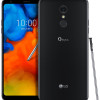 LG's Q Series Gains a Stylus
LG's Q Series Gains a Stylus
 iPhone 15 Series Goes All-In on USB-C and Dynamic Island
iPhone 15 Series Goes All-In on USB-C and Dynamic Island
 LG Stylo 4
LG Stylo 4










